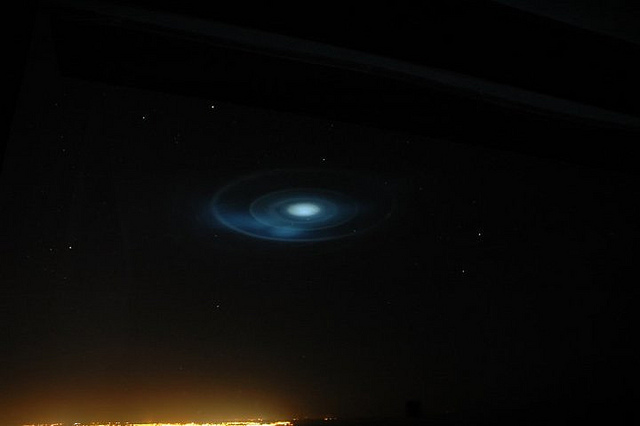
Last week saw the announcement of a private nonprofit program calling itself UFODATA, or UFO Detection And TrAcking. An op-ed was published by one of the group’s board members, Leslie Kean, in the Huffington Post, and now this week it’s gotten a little coverage in Mother Jones as well. The goal of the group seems to be to apply what these days we’re calling “citizen science” to the study of Unidentified Flying Objects (UFOs), or Unexplained Aerial Phenomena (UAP). I’ve been reading through their website, which was just launched last week, and trying to determine just what I think about the whole thing. Here’s what I want to say:
“Good luck and all, but don’t get your hopes up.”
The problem, for me — that is, what leads me to think they’re getting their hopes up — is their starting point. They believe there is something there to be explained. And I don’t think we’ve even proven that much yet.
The UFODATA program is fairly straightforward, at least on the surface. Build sky-watching sensor arrays at discrete locations around the world where UFO sightings are more common, (the Mother Jones article suggests “hotspots such as those in the western United States and in Hessdalen, Norway“) and watch the sky so that when something is captured, it can be explained by various means, like looking at the various spectra emitted, in UHF, VLF/ELF, infrared, etc., and measuring any radiation given off. It’s a genuine attempt at a kind of disinterested objectivity. For that I applaud them.
They’re also happy to have academics on the team — two PhDs in Astronomy, as well as a number of “silent advisors,” who are afraid of telling anyone of their involvement for (perfectly understandable) professional reasons.
But here’s why I think they’re going to be disappointed:
They’re decidedly in the camp that says UFOs are extra-terrestrial in origin.
Oh, sure, they make motions at impartiality, as the front page reads:
Setting aside for the moment the debate about whether there are, in fact, any “unexplained UFO reports,” they just aren’t unbiased. Kean’s op-ed makes perfectly clear, they’re basically just searching for little green men. She and her colleagues actually liken UFODATA to SETI, but “local”:
Rodeghier [one of UFODATAs cofounders] points out that we are simply taking SETI to its logical limit — local SETI. “Several researchers interested in the conventional search for ET have pushed the boundaries to suggest that it is not misguided to search in the solar system, including around the moon, for ET artifacts or other evidence for extraterrestrial intelligence,” he says. “But they have rejected looking in near-Earth orbit. Logically this prohibition makes no sense, and so with UFODATA we will also break the taboo of searching for signs of ET right here, not just millions of kilometers away.”
As I said, I applaud their attempt to make the whole UFO thing more data-based. Gathering hard data is definitely going to be an improvement over the eye-witness reports and shaky camera footage that tops the “best” evidence we’ve uncovered so far. But they’re mistaking two different kinds of airborne objects for one.
On the one hand, we have flying objects which are unidentified to science, and on the other we have flying objects which are unidentified to a small number of somewhat overenthusiastic people. What they’re almost certainly going to find — in UFO “hotspots” or not — is plenty of the latter and none of the former.
I mean think about it. Imagine, if you will, that you are an alien race with the power to cross intergalactic space. You come to Earth — for whatever reason — and haven’t been proven to exist in an age where basically one out of every two people on Earth is carrying a video camera. Not even once have a bunch of people seen and filmed something that wasn’t later demonstrated to be “unidentified” for longer than a few days (I’m being generous) to a skeptical eye. This suggests to me that if they are here (despite all this lack of evidence) that they don’t want to be proven to exist.
If that’s the case, they can probably evade a stationary set of cameras, if no other way than by just landing a couple towns over. And before you talk about covering all the skies at all time, remember that when you’re crowdfunding to the tune of $10,000-20,000 a pop, you’re going to need a hell of a lot more of them than you can afford.
But it might serve one useful purpose. If they set up one of these little stations in a place where a lot of sightings are reported, and if their station catches a number of sightings and can tell us with data that they’re weather balloons, Chinese lanterns, airplanes, helicopters, top-secret (but mundanely terrestrial) air force projects, or the planet Venus, then just maybe it’ll start to sink in that if we’re being visited by aliens, it’s not likely to be on public display.
So, good luck, intrepid researchers of the UFODATA program, but try not to be too disappointed when all you find is evidence of absence.
***
Richard Ford Burley is a doctoral candidate in English at Boston College, where he’s writing about remix culture and the processes that generate texts in the Middle Ages and on the internet. In his spare time he writes about science, skepticism, and feminism (and Fox Mulder) here at This Week In Tomorrow.
